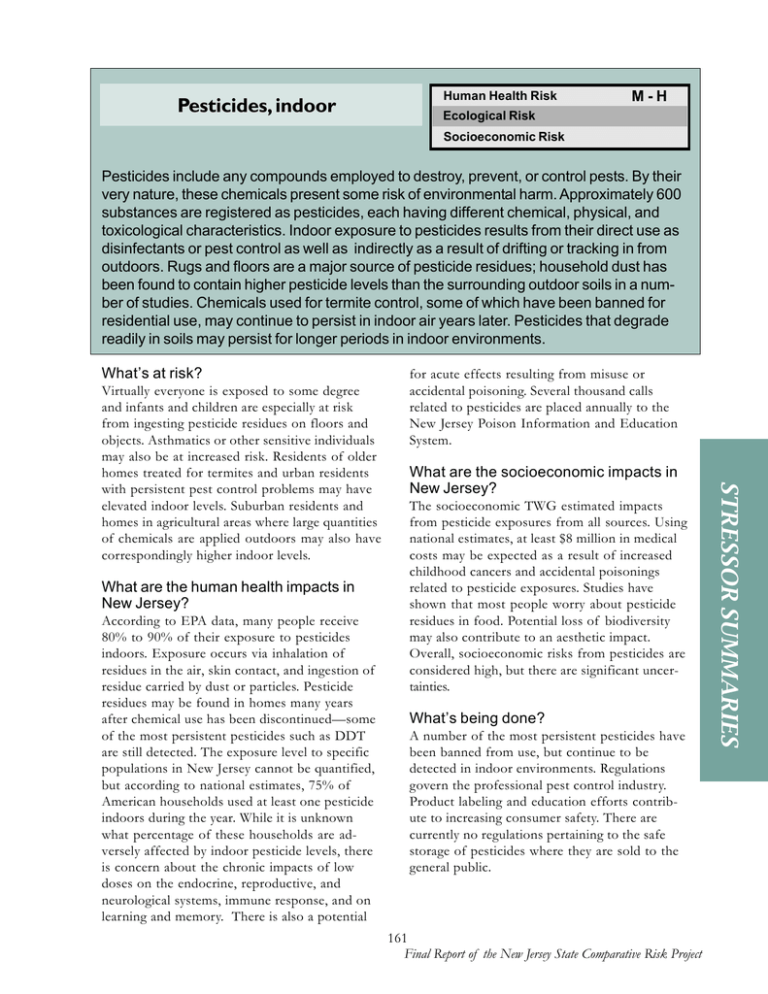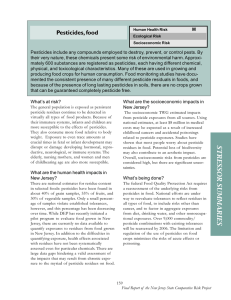Pesticides, indoor
advertisement

Pesticides, indoor Human Health Risk M-H Ecological Risk Socioeconomic Risk Pesticides include any compounds employed to destroy, prevent, or control pests. By their very nature, these chemicals present some risk of environmental harm. Approximately 600 substances are registered as pesticides, each having different chemical, physical, and toxicological characteristics. Indoor exposure to pesticides results from their direct use as disinfectants or pest control as well as indirectly as a result of drifting or tracking in from outdoors. Rugs and floors are a major source of pesticide residues; household dust has been found to contain higher pesticide levels than the surrounding outdoor soils in a number of studies. Chemicals used for termite control, some of which have been banned for residential use, may continue to persist in indoor air years later. Pesticides that degrade readily in soils may persist for longer periods in indoor environments. What’s at risk? What are the human health impacts in New Jersey? According to EPA data, many people receive 80% to 90% of their exposure to pesticides indoors. Exposure occurs via inhalation of residues in the air, skin contact, and ingestion of residue carried by dust or particles. Pesticide residues may be found in homes many years after chemical use has been discontinued—some of the most persistent pesticides such as DDT are still detected. The exposure level to specific populations in New Jersey cannot be quantified, but according to national estimates, 75% of American households used at least one pesticide indoors during the year. While it is unknown what percentage of these households are adversely affected by indoor pesticide levels, there is concern about the chronic impacts of low doses on the endocrine, reproductive, and neurological systems, immune response, and on learning and memory. There is also a potential for acute effects resulting from misuse or accidental poisoning. Several thousand calls related to pesticides are placed annually to the New Jersey Poison Information and Education System. What are the socioeconomic impacts in New Jersey? The socioeconomic TWG estimated impacts from pesticide exposures from all sources. Using national estimates, at least $8 million in medical costs may be expected as a result of increased childhood cancers and accidental poisonings related to pesticide exposures. Studies have shown that most people worry about pesticide residues in food. Potential loss of biodiversity may also contribute to an aesthetic impact. Overall, socioeconomic risks from pesticides are considered high, but there are significant uncertainties. What’s being done? A number of the most persistent pesticides have been banned from use, but continue to be detected in indoor environments. Regulations govern the professional pest control industry. Product labeling and education efforts contribute to increasing consumer safety. There are currently no regulations pertaining to the safe storage of pesticides where they are sold to the general public. 161 Final Report of the New Jersey State Comparative Risk Project STRESSOR SUMMARIES Virtually everyone is exposed to some degree and infants and children are especially at risk from ingesting pesticide residues on floors and objects. Asthmatics or other sensitive individuals may also be at increased risk. Residents of older homes treated for termites and urban residents with persistent pest control problems may have elevated indoor levels. Suburban residents and homes in agricultural areas where large quantities of chemicals are applied outdoors may also have correspondingly higher indoor levels.







